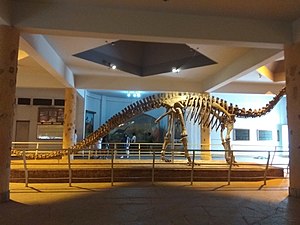Kotasaurus
| Kotasaurus | ||||||||||
|---|---|---|---|---|---|---|---|---|---|---|

Skeleton reconstruction in a museum |
||||||||||
| Temporal occurrence | ||||||||||
| Lower Jurassic ( Sinemurian to Pliensbachian ) | ||||||||||
| 199.3 to 182.7 million years | ||||||||||
| Locations | ||||||||||
| Systematics | ||||||||||
|
||||||||||
| Scientific name | ||||||||||
| Kotasaurus | ||||||||||
| Yadagiri, 1988 | ||||||||||
| Art | ||||||||||
|
||||||||||
Kotasaurus is a genus of dinosaurs and a very early representative of the sauropods . The only species Kotasaurus yamanpalliensis comes from the Kota formation from the Lower Jurassic of India ( Sinemurium to Pliensbachium ), so that Kotasaurus sharedits habitat with the related Barapasaurus . The remains discovered so far belong to at least 12 different individuals. Most of the skeleton is known, but only two teeth have been found on the skull. Like all sauropods, the Kotasaurus was a large, four-legged herbivore with a long neck and tail.
features
Kotasaurus is one of the most original known sauropods. Although the general physique is that of a typical sauropod, in numerous original ( plesiomorphic ) characteristics this genus resembles the " prosauropods ", the forerunners of the sauropods. Like all other sauropods, Kotasaurus was obligately four-legged , in contrast to the two-legged prosauropods. The body length was about 9 meters and was thus already comparable to that of the later sauropods. The femur was straight and oval in cross-section, suggesting columnar legs. The teeth were spoon-shaped and thus correspond to those of later sauropods. Original features, on the other hand, can be seen, for example, on the humerus, which was still relatively short and slightly rotated. The small rolling hillock ( lesser trochanter ) was still present on the femur . The vertebrae were simply built and massive - weight-reducing cavities, such as those found in the contemporary Barapasaurus , are missing.
Newly acquired features ( autapomorphies ) of Kotasaurus were the relatively slender leg bones as well as the low and long pre-acetabular process (the forward-facing process of the iliac bone ).
Systematics
At first it was unclear whether Kotasaurus was already a real sauropod or a precursor form closely related to the sauropod. Often this genus was combined with Vulcanodon , Barapasaurus , Ohmdenosaurus and Zizhongosaurus to form a family called Vulcanodontidae very early sauropods. Today, however, this group is considered paraphyletic and therefore invalid.
Today Kotasaurus is considered to be one of the most original known sauropods, but the exact relationships are unclear. A recent study by Bandyopadhyay and colleagues (2010) concludes that Kotasaurus is more primitive than Vulcanodon and Barapasaurus , but more advanced than Chinshakiangosaurus and Antetonitrus .
| Cladogram , simplified from Bandyopadhyay and colleagues, 2010: | ||||||||||||||||||||||||||||||||||||||||||||||||||||||
|---|---|---|---|---|---|---|---|---|---|---|---|---|---|---|---|---|---|---|---|---|---|---|---|---|---|---|---|---|---|---|---|---|---|---|---|---|---|---|---|---|---|---|---|---|---|---|---|---|---|---|---|---|---|---|
|
||||||||||||||||||||||||||||||||||||||||||||||||||||||
| Systematic position of Kotasaurus |
Finds and naming
All known fossils come from a 2.4 km² area near the village of Yamanpalli in the Indian state of Andhra Pradesh , about 40 km north of the Barapasaurus discovery site. The total of 840 skeletal parts were recovered in the late 1970s and scientifically described by P. Yadagiri as Kotasaurus yamanpalliensis in 1988 . Today the fossils are archived in the collection of the Geological Survey of India in Hyderabad .
Kotasaurus is named after the Kota formation , from the lower section of which the fossils come. The second part of the species name - yamanpalliensis , refers to the village of Yamanpalli, in the vicinity of which the site is located.
Individual evidence
- ↑ Saswati Bandyopadhyay, David D. Gillette, Sanghamitra Ray, Dhurjati P. Sengupta: Osteology of Barapasaurus tagorei (Dinosauria: Sauropoda) from the Early Jurassic of India. In: Palaeontology. Vol. 53, No. 3, 2010, ISSN 0031-0239 , pp. 533-569, here p. 535, doi : 10.1111 / j.1475-4983.2010.00933.x .
- ↑ a b c d e P. Yadagiri: The osteology of Kotasaurus yamanpalliensis, a sauropod dinosaur from the Early Jurassic Kota Formation of India. In: Journal of Vertebrate Paleontology. Vol. 21, No. 2, 2001, ISSN 0272-4634 , pp. 242-252, doi : 10.1671 / 0272-4634 (2001) 021 [0242: TOOKYA] 2.0.CO; 2 .
- ^ A b c Donald F. Glut : Dinosaurs. The Encyclopedia. McFarland & Company, Jefferson NC et al. 1997, ISBN 0-89950-917-7 , pp. 521-522.
- ^ Gregory S. Paul : The Princeton Field Guide to Dinosaurs. Princeton University Press, Princeton NJ et al. 2010, ISBN 978-0-691-13720-9 , p. 172.
- ↑ a b Saswati Bandyopadhyay, David D. Gillette, Sanghamitra Ray, Dhurjati P. Sengupta: Osteology of barapasaurus tagorei (Dinosauria: Sauropoda) from the Early Jurassic of India. In: Palaeontology. Vol. 53, No. 3, 2010, pp. 533-569, here p. 562, doi : 10.1111 / j.1475-4983.2010.00933.x .
- ↑ P. Yadagiri: A new sauropod Kotasaurus yamanpalliensis from Lower Jurassic Kota Formation of India. In: Records of the Geological Survey of India. Vol. 116, No. 3/8, 1988, ISSN 0370-5226 , pp. 102-127.
- ↑ Ben Creisler: Dinosauria Translation and Pronunciation Guide. Archived from the original on July 10, 2011 ; accessed on August 15, 2014 .